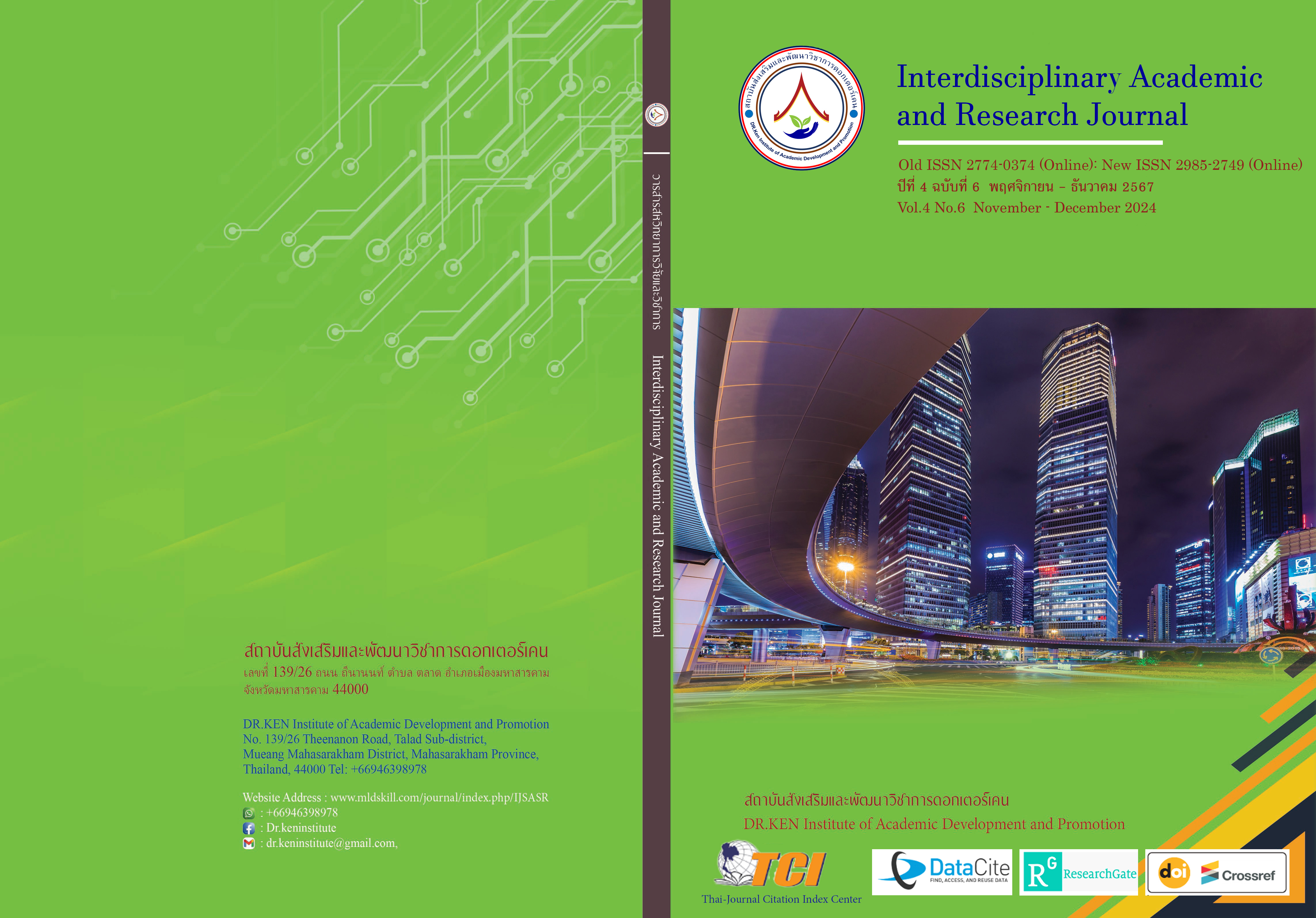Creation of the Identity of Karen Hand-Woven Fabrics to Increase Their Ability to Add Value to Waste Products, Ban Tee Kapo, Chalong Subdistrict, Phop Phra District, Tak Province
DOI:
https://doi.org/10.60027/iarj.2024.281427Keywords:
Identity of Hand-Woven Fabric, Value-Added Capacity, Waste ProductsAbstract
Background and Aims: The identity of Karen hand-woven fabrics The identity pattern that will be developed will be able to add value to the product. For natural dyeing, the weaving group of Ban Tee Kapo already has knowledge about dyeing. However, the problems found from natural dyeing that the group encountered were that the dyed color was not bright and the color faded. The research team will fix the dyeing problem to prevent the color from fading as new knowledge for the group. The research team also sees the importance of woven fabric products that are expensive and take a long time to weave. In this regard, the research team will search for and increase the product designs to be diverse and not too expensive to be another option for the group's customers.
Methodology: This research is a qualitative research. Data were collected from interviews with the Tee Kapo Community Enterprise Group and Tee Kapo Weaving Group, Chong Khaep Subdistrict, Phop Phra District, Tak Province. The objectives are: 1) to create the identity of Tee Kapo woven fabric patterns, 2) to create new knowledge in natural dyeing, and 3) to create added value. The research team used data obtained from content analysis, village history, important people, important places, food, traditions/beliefs, trees, animals, flowers, colors, language, handicrafts, leisure activities, and fabric pattern names. Descriptive data was collected from focus group discussions and semi-structured interviews from woven fabric products from the research sample groups, including the village headman of Tee Kapo, members of the Chong Khaep Subdistrict Administrative Organization, Tee Kapo Weaving Group, Tee Kapo Community Enterprise Group, Tee Kapo School Director, and 30 people. The tools used in this data collection were focus group discussions and semi-structured interviews. The interview questions were pre-determined as open-ended questions to allow the sample group to express their opinions fully. Without guiding the answer, the data was summarized and synthesized by separating into categories and cutting out duplicate data to obtain important information. The data was summarized with experts in fabric design to draft the outline of the fabric pattern. Finally, the research team conducted in-depth interviews by inviting experts in fabric design and weaving groups to obtain information on fabric patterns and methods of fabric pattern making, and analyzed the content (Content Analysis) of village history, important people, important places, food, traditions/beliefs, trees, animals, flowers, colors, language, handicrafts, leisure activities, fabric pattern names, and obtained descriptive data.
Results: The research results revealed that the fabric pattern that serves as Ban Tee Kapo's identity is a stream, which translates to a pond. It is known as "Tee Kapo" in Karen, which is also the village's name. It reflects the villagers' identities while also remaining consistent with the village's name. Furthermore, there are additional patterns that are the original patterns of the Karen ethnic group, which are woven together with the stream and flower patterns of Nee Ke Po Tu Yo (Jor Tho (brocade fabric)) to create new knowledge in natural dyeing. About the dyeing of fabrics in every step And there is still the issue that the dyeing is not yet permanent and durable. As a result, the research team held a workshop in which experts in dyeing fabrics practiced with weavers in three steps: preparation, dyeing, and washing, in order to create added value for new products that the market of ethnic product users enjoys, such as fashion shirts, bags, accessories, shoes, placemats, and tablecloths.
Conclusion: The formation of a person's identity is a dynamic, ongoing process that accumulates over time, allowing individuals to express their unique identity in various contexts. Similarly, incorporating traditional natural dyeing techniques into modern products increases the value of ethnic fashion items such as shirts, bags, and accessories, making them more appealing to modern markets while also preserving cultural heritage.
References
กันทนา ใจสุวรรณ (2563). งานปักลูกเดือย ภูมิปัญญาบนผ้าทอกะเหรี่ยง. วิทยาลัยชุมชนแม่ฮ่องสอน. Retrieved from: https://www.okmd.or.th/upload/pdf/2560/KC/Embroidery.pdf
จิตตินุช วัฒนะ. (2555). การศึกษาเพื่อกําหนดอัตลักษณ์ถนนวัฒนธรรม (ถนนคนเดิน) ของจังหวัด พิษณุโลก. วารสารบริหารธุรกิจ เศรษฐศาสตร์และการสื่อสาร, 7(2), 71-80.
ตระกูล พันธ์พัชรเมธา. (2557). การสร้างภาพลักษณ์ผลิตภัณฑ์เพื่อกำหนดแนวคิด การออกแบบ. ศิลปกรรมสาร, คณะศิลปกรรมศาสตร์ มหาวิทยาลัยธรรมศาสตร์. 9 (1), 51-63.
ภาวิดา มหาวงศ์ สุพัตรา เจริญภักดี บดีรัฐ ธัญญพร มาบวบ อุษา อินทร์ประสิทธิ์ และยุวดี พ่วงรอด. (2566). การศึกษาวิเคราะห์ภูมินามกับสิ่งแวดล้อมธรรมชาติ ศิลปกรรมท้องถิ่น ประเพณี ภูมิปัญญา และประติมากรรมรูปภาพ ของอำเภอชาติตระการ จังหวัดพิษณุโลก. การประชุมวิชาการระดับชาติพิบูลสงครามวิจัย ครั้งที่ 8 การวิจัยและนวัตกรรมสู่การพัฒนาที่ยั่งยืน (SDGs) 28 กุมภาพันธ์ 2566 ณ มหาวิทยาลัยราชภัฎพิบูลสงคราม.
ศักดิ์สิทธิ์ คำหลวง และศุภรัก สุวรรณวัจ. (2560). การออกแบบอัตลักษณ์องค์กรชุมชนกาดกองต้า โดยใช้ทฤษฎีสัญศาสตร์ต่อการรับรู้ทุนวัฒนธรรมชุมชนกาดกองต้า จังหวัดลำปาง. วารสารวิชาการศิลปะสถาปัตยกรรมศาสตร์มหาวิทยาลัยนเรศวร. 8(1), 24 – 39.
ศูนย์ข้อมูลกลางทางวัฒนธรรม (2564). ประโยชน์ของผ้าไหม. Retrieved 1 November 2023, from : http://www.m-culture.in.th/.
ศูนย์สารนิเทศอีสานสิรินธร. (2566). สีธรรมชาติ. Retrieved 1 November 2023, from : https://library.msu.ac.th/isancenter/
สำนักงานพัฒนาชุมชนจังหวัดตาก. (2566). จำนวนประชากรตำบลช่องแคบ อำเภอพบพระ จังหวัดตาก. Retrieved on 22 November 2023, from: https://tak.cdd.go.th/.
สุจรรยา โชติช่วง. (2554). การศึกษาสภาพการพัฒนาอัตลักษณ์และเอกลักษณ์ของสถานศึกษา สังกัด สำนักงาน เขตพื้นที่การศึกษาประถมศึกษาพิษณุโลก เขต 1. การศึกษาค้นคว้าด้วยตนเอง กศ.ม. สาขาวิชาการบริหารการศึกษา มหาวิทยาลัยนเรศวร.
อินทิรา พงษ์นาค และศุภกรณ์ ดิษฐพันธุ์. (2558). อัตลักษณ์ชุมชนเมืองโบราณอู่ทอง จังหวัดสุพรรณบุรี.Veridian E - Journal,Slipakorn University, 8(2), 511 – 523.
DOBBYTEX ADMIN. (2566). การย้อมผ้าฝ้ายทอมือด้วยสีที่ได้จากธรรมชาติ. Retrieved on 15 November 2023, from https://www.dobbytexfabric.com/.
Downloads
Published
How to Cite
Issue
Section
License
Copyright (c) 2024 Interdisciplinary Academic and Research Journal

This work is licensed under a Creative Commons Attribution-NonCommercial-NoDerivatives 4.0 International License.
Copyright on any article in the Interdisciplinary Academic and Research Journal is retained by the author(s) under the under the Creative Commons Attribution-NonCommercial-NoDerivatives 4.0 International License. Permission to use text, content, images, etc. of publication. Any user to read, download, copy, distribute, print, search, or link to the full texts of articles, crawl them for indexing, pass them as data to software, or use them for any other lawful purpose. But do not use it for commercial use or with the intent to benefit any business.
















.png)


